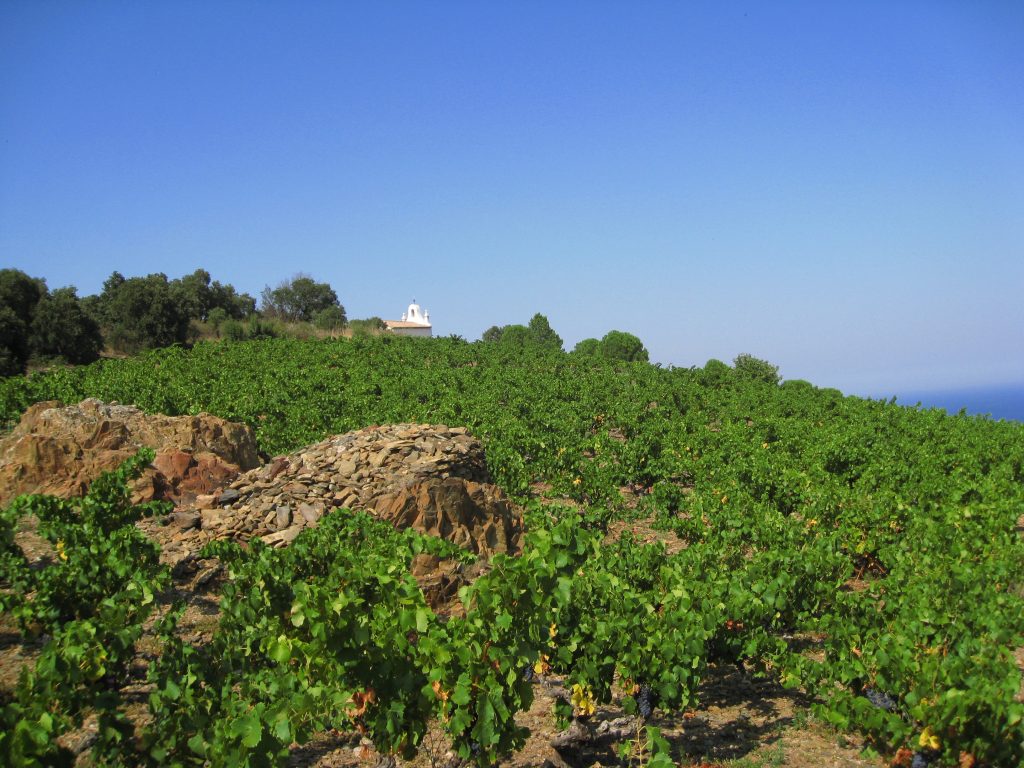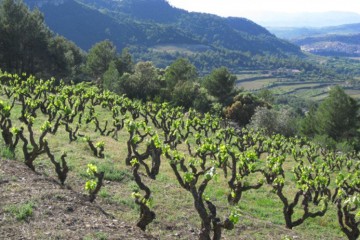Palate Savvy/Sud de France Instagram Live Wine Basic Seminars: Vin Doux Naturel!
Roussillon is one of those places in which one realizes that France is not just France. That is, that France, one of the oldest coherent nation states in Europe – or possibly, in the world, in fact, contains several different cultures within it. Within modern memory, say the past century, France’s connection to Alsace was contested, to speak mildly, by Germany. Today many Corsicans seek to separate their enchanted Ile de Beauté from the cruel, albeit elegant clutches of Paris. And, there is a revival of interest regional languages: Breton, Occitan, Picard, Basque, Alsatian, etc.
But, perhaps no region in the continental territory of France (as opposed to an island like Corsica) is so distinctly non-French as Roussillon – aka the Pays Catalans. Crossing into the Pyrénées-Orientales département from neighboring Aude, one might be struck by the fact that many signs are in two languages – French and Catalans. A similar phenomenon exists in parts of the Languedoc, too, signs giving both French and Occitan names, but that’s more symbolic than practical, since few Languedociennes actually do speak Occitan in any practical way. Not so in the Roussillon, where Catalan is the language of choice in many places. (Though, use of French doesn’t provoke the same issues as using Castellano in some places across the frontier with Spain. I recall a visit with a small number of other American writers – to winemakers in Catalonia of Spain – for the sake of clarity, I’ll use ‘Catalunya’ to refer to the Catalan portions of Spain). The latter addressed us in Catalan, which none of the Americans spoke. Some of us – those who spoke Spanish or French – got the gist of what they were saying, but there were gaps. When I asked a couple of questions in Spanish, I was inevitably answered in Catalan. Bothered by what I saw as a gratuitous assertion of Catalans nationalism, I said in Spanish: I don’t understand why you have us here if you don’t want to communicate with us in the most direct way. Whatever your politics, you all speak Castellano. Some of us do, too. And some of us speak French. All of us speak English. None of us speak Catalan. So, could you please use one of those other languages?” After an embarrassing pause, the speaker changed to Castellano.)
The connection between the Languedoc-Roussillon, Roussillon especially, and the Iberian peninsula, extends over millennia. Clearly, they’re neighbors. The halcyon days of Roman Empire brought the Via Domitia to the region, which, its completion in 118 BCE connected Italy with important Roman colonies in Hispania. Portions of the Via Domitia became an important southern trail for pilgrims traveling to the shrine of St James in Galicia: Santiago de Compostela /St Jacques de Compostelle, and today, it is largely the footprint of France’s A9 highway, aka La Languedocienne in the Languedoc and La Catalane in Roussillon. Way further back in history, Hannibal purportedly left a trail of elephant droppings on the same path as he made his way to Rome in the third century BCE.
At various points in history apart from Rome, portions of the Languedoc-Roussillon and what is today Spain were governed by the same rulers. In the 13th century CE political disruptions brought or withdrew Iberian control from the region. Jaume I (aka James I, aka Jacques I ) was born in Montpellier. After assuming the throne of Aragon (Spain) , he then conquered the Moorish rulers of the Balearic Islands, and put much of today’s Languedoc-Roussillon under the suzerainty of Mallorca, which was eventually governed by his son Jaume II from Perpignan, today Roussillon’s capital and most important city. King Louis IX, in his contestations with various powers in Europe, the Aragonese not the least, exerted tremendous pressure on Jaume I (and, visa versa). Their accord of 1258, known as the Treaty of Corbeil, more or less settled their differences. Louix IX renounced claims in the Iberian peninsula – especially in Catalunya and much of the coastal portions of the Languedoc-Roussillon, and Jaume I did the same for his claims in Gaul (i.e., France), including more inland portions of today’s Languedoc-Roussillon. Enthusiasts of the gerrymandering game might take delight the map of the Languedoc that was drawn, which gave Montepellier and Aumelas to Jaume, and Béziers and Narbonne – which almost touches the Mediterranean between Montepellier and Perpignan – to Louis.
Before his passing in 1276, Jaume passed control of Mallorca (including Montpellier) to his son Jaume II (other sons got other portions of his possessions), which, again, was ruled from Perpignan and included Montpellier. Montpellier was, as it remains today, a leading center for research and knowledge. Among Jaume II’s subject was the physician/scientist/alchemist/astrologer/theologian/diplomat Arnau de Vilanova aka Arnauld de Villeneuve aka, many other versions. As one might assume through his extensive CV, Vilanova was a man of many talents (it’s hard to know if the expression ‘Jack of all trades, Master of none, might apply. We know he certainly never was able to turn lead into gold). Of most importance to the history of wine was his articulation in 1285 of the process he called ‘mutage’ to stabilize and preserve the sweetness of a wine through fortification with alcohol. Known as vin doux naturel these fortified sweet wines centuries later became the basis of the wine economy in the Roussillon, which in the 20th century, recognized five distinct appellations in which these sorts of wines were made: Banyuls, Banyuls Grand Cru, Maury, Muscat de Rivesaltes, and Rivesaltes. I’ll save discussion about these for another time. Jaume II, who was said to have been a great fan of these sorts of wines (which were forerunners of Port and Madeira), awarded Vilanova a patent for the process in 1299. It seems that patent offices worked slowly back then, too.
For the next two and a half centuries, minus a few adjustments (not the least of which was the Jaume III’s sale of Montpellier to the French crown in 1349), the Roussillon remained in Spanish hands until 1659, when the Treaty of the Pyrénées that ended the Thirty Years War between France and Spain, ceded control of the Roussillon to France, as it remains to the present.
Despite being officially French, Catalan identity has remained strong in Roussillon. Something like 35% claim to speak it fluently, and another 25% say they understand it. Indeed, le Pays Catalans arguably shares a great deal more with the Catalans across the border than they do with even their co-regionalists the Languedocians. That Catalan nationalists refer to the Roussillon as ‘Nord Catalunya,’ is as much descriptive as it is aspirational. Interestingly, though, the affection and support French Catalans might feel for their kin next door, has not translated to significant demands for Catalan independence from France, even to join a Catalunya made independent from Spain. Social scientists have undoubtedly examined the reasons why – comparing the grievances the Catalan communities in each country have suffered. Surely, in France, there was no anti-Catalan campaign that compared to that in Spain during the nearly 40-year Franco dictatorship. Moreover, relatively speaking, Catalunya is a prosperous, industrial region compared to the Roussillon, whose economy remains rooted in agriculture and tourism. Whereas people in Barcelona might complain that they send more money to Madrid than they receive in support of services, the same cannot be justifiably said of Perpignan tax-payers and Paris. (Which isn’t to say that people don’t still complain). Folks in the Roussillon potentially have a lot more to lose by leaving France than those in Catalunya have in seceding from Spain.
While the Roussillon is connected to the Languedoc by a hyphen (a few other things, too), one might say that there seems something a touch different about its wines. While appellation rules have similar requirements in terms of permitted grape varieties, for reds, the southern French collection that includes Grenache Noir, Carignan, Cinsault, Syrah, and Mourvèdre, many of the wines seem – well, more Catalan than French. It’s hard to quantify why, exactly. They just do, maybe on account of shared local flora, maybe because Grenache spelled with an ‘x’ – Garnatxa – takes a different form, maybe because winemakers on both sides of the border share thoughts in a language that is their own? Anyway, I’m generalizing. There are several expressions of wine in the Roussillon, just as there are in Catalunya.
(I’ll add here that folks in the Fenouilèdes, in the northwest corner of Roussillon, tend to consider themselves French rather that Catalan, though their wines share the same character as others from Roussillon).
There is a great deal to say about this all, but to make things simple from the start, I’ll be doing another Sud de France Instagram Live Wine Basics seminar tomorrow (Wednesday, April 15) at 1pm EST (19h France, 10am California) in which I talk about some the history, the appellations, the grapes, and the wines of Roussillon. Fifteen minutes, give or take, short and sweet.
Please go to @SuddeFranceny on Instagram to join live. The broadcast will be up for 24 hours from them, and hopefully archived on this site afterward.



